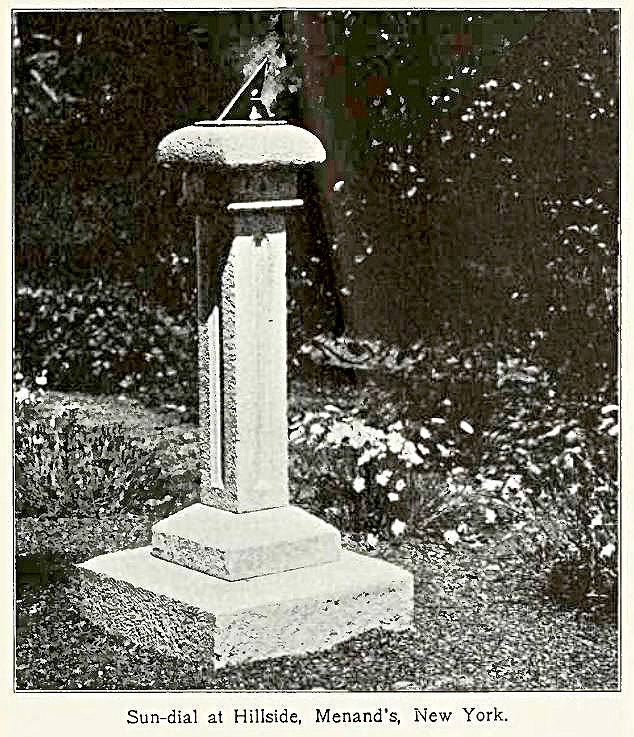What's New Under The Sun
Madison Historic Dial Returns
Monday, 13 October 2025 22:49
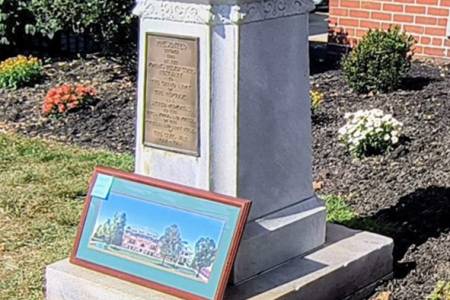 On October 4, 2025 Madison Historical Society of Ohio was able to have their sundial returned after 32 years, when in 1993 it was moved to the lawn of Lake County Courthouse to reduce the chance of vandalism. The sundial was originally placed at Madison Home 100 years ago on Saturday, October 24, 1925 during a conference of the Women's Relief Society. From 1904 to 1962 the state ran this...
On October 4, 2025 Madison Historical Society of Ohio was able to have their sundial returned after 32 years, when in 1993 it was moved to the lawn of Lake County Courthouse to reduce the chance of vandalism. The sundial was originally placed at Madison Home 100 years ago on Saturday, October 24, 1925 during a conference of the Women's Relief Society. From 1904 to 1962 the state ran this...
Elements of Dialing Course - 2025
Monday, 15 September 2025 19:42
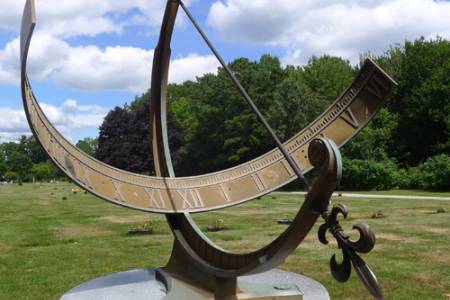 NASS is pleased to announce the upcoming fifth instance of Elements of Dialing, our introductory course about sundials, their history, and the science that makes them work. The free 12-lesson course, intended for those are new to sundialing, runs from 27 October 2025 until 26 April 2026. The course instructor is Robert Kellogg, NASS Vice President and Sundial Registrar. Bob will be...
NASS is pleased to announce the upcoming fifth instance of Elements of Dialing, our introductory course about sundials, their history, and the science that makes them work. The free 12-lesson course, intended for those are new to sundialing, runs from 27 October 2025 until 26 April 2026. The course instructor is Robert Kellogg, NASS Vice President and Sundial Registrar. Bob will be...
Sun Queen of World War II
Thursday, 11 September 2025 23:11
 A Hungarian born American scientist, Mária Telkes (1900-1995), was called "The Sun Queen" and among other honors, was postmousthly inducted into the National Inventors Hall of Fame. She lived to 95 and for most of her life developed solar power in a variety of forms.
Trained as a biophysicist, she worked for Westinghouse Electrical and Manufacturing Company in Pittsburgh, PA, where she...
A Hungarian born American scientist, Mária Telkes (1900-1995), was called "The Sun Queen" and among other honors, was postmousthly inducted into the National Inventors Hall of Fame. She lived to 95 and for most of her life developed solar power in a variety of forms.
Trained as a biophysicist, she worked for Westinghouse Electrical and Manufacturing Company in Pittsburgh, PA, where she...
2025 Conference -Ottawa
Thursday, 28 August 2025 23:25
 The annual NASS Conference was held 7-10 August, 2025 in Ottawa. As usual, the conference began late Thursday afternoon with an introduction social and a "grab bag give away", taking your chances with tickets to win the bag's prize. Will Grant was the final winner of the Walton Double Planar Polar Sundial, but Paul Ulbrich beat the statistic odds and won this prize three times,...
The annual NASS Conference was held 7-10 August, 2025 in Ottawa. As usual, the conference began late Thursday afternoon with an introduction social and a "grab bag give away", taking your chances with tickets to win the bag's prize. Will Grant was the final winner of the Walton Double Planar Polar Sundial, but Paul Ulbrich beat the statistic odds and won this prize three times,...
Prosciutto di Portici Sundial's Owner
Tuesday, 10 June 2025 18:51
 Prosciutto di Portici (Ham) Sundial
Photo: Getty Images
The Prosciutto di Portici Sundial, more often called the Portici Ham Sundial, dates from the first century somewhere between 8 BCE to 79 CE. This small silvered bronze dial was uncovered on 11 June, 1755 in the ruins of Herculaneum (current day Portici) in the "Villa of the Papyri", buried in...
Prosciutto di Portici (Ham) Sundial
Photo: Getty Images
The Prosciutto di Portici Sundial, more often called the Portici Ham Sundial, dates from the first century somewhere between 8 BCE to 79 CE. This small silvered bronze dial was uncovered on 11 June, 1755 in the ruins of Herculaneum (current day Portici) in the "Villa of the Papyri", buried in...
Hamilton Dial Dedicated
Friday, 06 June 2025 21:01
 Sundial dedication May 31, 2025. At left is Kathleen Stuckey Fox, with the City Proclamation presented by Mayor Pat Moeller and City Council on-lookers Carla Fiehrer and Susan Vaughn offering congratulations.
On May 31, 2025 at 1pm, the Hamilton, Ohio, sundial (NASS Sundial Registry #1109) was re-dedicated in Monument Park. Originally dedicated in 1941 to the...
Sundial dedication May 31, 2025. At left is Kathleen Stuckey Fox, with the City Proclamation presented by Mayor Pat Moeller and City Council on-lookers Carla Fiehrer and Susan Vaughn offering congratulations.
On May 31, 2025 at 1pm, the Hamilton, Ohio, sundial (NASS Sundial Registry #1109) was re-dedicated in Monument Park. Originally dedicated in 1941 to the...
Frans Maes Received a Royal Decoration
Monday, 24 March 2025 21:33
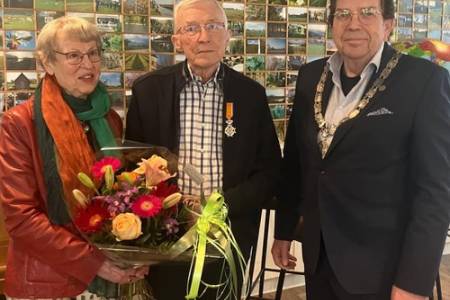 Several years ago Frans decided to write the course on sundials that included self assessment questions to force students not only to read the text, but to internalize the concepts. And a final submittal question "not necessarily a difficult question, but: no answer, no new lesson." Thus Frans Maes began writing lessons and sending them out to students.
NASS has now used his material to create...
Several years ago Frans decided to write the course on sundials that included self assessment questions to force students not only to read the text, but to internalize the concepts. And a final submittal question "not necessarily a difficult question, but: no answer, no new lesson." Thus Frans Maes began writing lessons and sending them out to students.
NASS has now used his material to create...
Pros and Cons of Daylight Savings Time
Monday, 24 March 2025 15:37
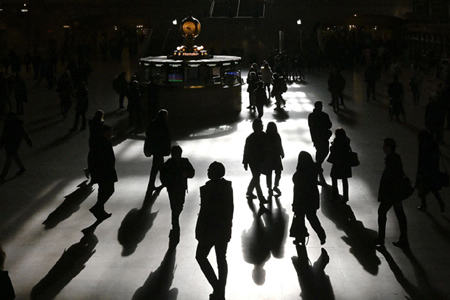 In a 24 March 2025 article from the on-line Science Advisor (American Association for the Advancement of Science) Phie Jacobs summarizes the "great debate" of the yearly shift from standard time to daylight savings time. In January 2025 the US Senate introduced the Sunshine Protection Act to permanently have daylight savings time year round. Certainly 54% of Americans do not like the...
In a 24 March 2025 article from the on-line Science Advisor (American Association for the Advancement of Science) Phie Jacobs summarizes the "great debate" of the yearly shift from standard time to daylight savings time. In January 2025 the US Senate introduced the Sunshine Protection Act to permanently have daylight savings time year round. Certainly 54% of Americans do not like the...
Native American Moon Alignment Ring
Friday, 21 March 2025 19:26
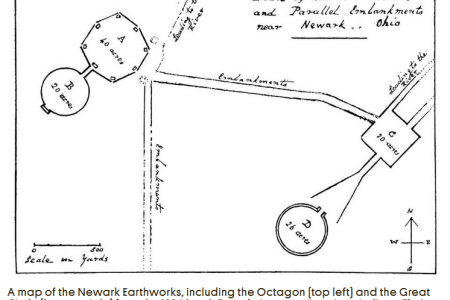 Perhaps the most famous alignment circle in the United States is the Cahokia Woodhenge near St. Louis constructed between 700-1400 CE by Cahokia Indigenous native Americans. But there were an estimated 10,000 other earthen mounds that once were scatter across the mid-west..
In an article from Atlas Obscura (https://www.atlasobscura.com/articles/octagon-earthworks-ohio) by Olivia Young on March...
Perhaps the most famous alignment circle in the United States is the Cahokia Woodhenge near St. Louis constructed between 700-1400 CE by Cahokia Indigenous native Americans. But there were an estimated 10,000 other earthen mounds that once were scatter across the mid-west..
In an article from Atlas Obscura (https://www.atlasobscura.com/articles/octagon-earthworks-ohio) by Olivia Young on March...
Hamilton Dial under Restoration
Friday, 21 March 2025 18:37
 The Hamilton dial is in the restorative care of Jarrett and Celene Hawkins (Hawkins & Hawkins Custom, LLC in Cincinnati Ohio https://www.studio-hawkins.com/) in preparation for the dial's dedication on Saturday, May 31, 2025.
The face of the Hamilton Grand Army of the Republic (GAR) sundial has been cleaned and bead-blasted showing the dial as it was cast 84 years ago. In the process,...
The Hamilton dial is in the restorative care of Jarrett and Celene Hawkins (Hawkins & Hawkins Custom, LLC in Cincinnati Ohio https://www.studio-hawkins.com/) in preparation for the dial's dedication on Saturday, May 31, 2025.
The face of the Hamilton Grand Army of the Republic (GAR) sundial has been cleaned and bead-blasted showing the dial as it was cast 84 years ago. In the process,...
VSSC Space Museum gets Polar Sundial
Tuesday, 17 December 2024 23:47
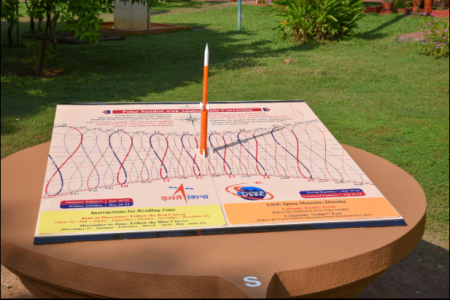 In November 2024, a team consisting of members from SPL, TTDG and CMD of VSSC successfully designed and installed an accurate and fully functional sundial at the Rocket Garden of VSSC Space Museum, Thumba (8.53°N, 76.86°E). Following a space theme, the vertical gnomon is a 3-stage rocket that casts its daily and seasonal shadow on a dial face 1 1/2 meters by 1 meter. The the sundial face...
In November 2024, a team consisting of members from SPL, TTDG and CMD of VSSC successfully designed and installed an accurate and fully functional sundial at the Rocket Garden of VSSC Space Museum, Thumba (8.53°N, 76.86°E). Following a space theme, the vertical gnomon is a 3-stage rocket that casts its daily and seasonal shadow on a dial face 1 1/2 meters by 1 meter. The the sundial face...
Historic Sundials of Andalusia
Saturday, 16 November 2024 00:07
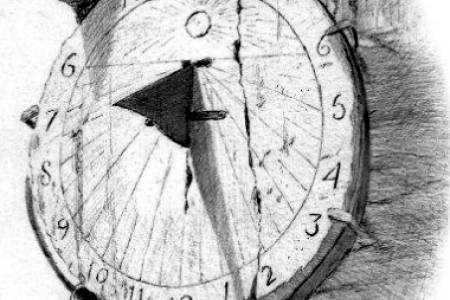 Esteban Martínez Almirón has published a new book Historical Sundials: Forgotten Andalusian Treasures (Relojes de Sol Históricos Tesoros Andaluces Olvidados) In it he reviews over 400 sundials from the Andalucian region of southern Spain Originally to celebrate the 25th year of the website https://relojandalusi.org/
Esteban Martínez Almirón began showing his sundial drawings on the site....
Esteban Martínez Almirón has published a new book Historical Sundials: Forgotten Andalusian Treasures (Relojes de Sol Históricos Tesoros Andaluces Olvidados) In it he reviews over 400 sundials from the Andalucian region of southern Spain Originally to celebrate the 25th year of the website https://relojandalusi.org/
Esteban Martínez Almirón began showing his sundial drawings on the site....
Smithsonian Photo Contest - Jaipur Sundial
- Details
- Hits: 6261
Smithsonian Magazine holds a photo-of-the-day contest. Winner on 30 Oct 2023 was Harita Sistu who took a photo of the large sundial of Jantar Mantar, Jaipur India (taken in July 2022). Harita notes: "I wanted to try my best to capture just how massive the instrument is and bring focus into the incredible skill that went into designing and constructing it."
 Harita Sistu - Award winning photo of the Equatorial Sundial at Jaipur, India
Harita Sistu - Award winning photo of the Equatorial Sundial at Jaipur, India
Indiana French Dial Found
- Details
- Hits: 7533
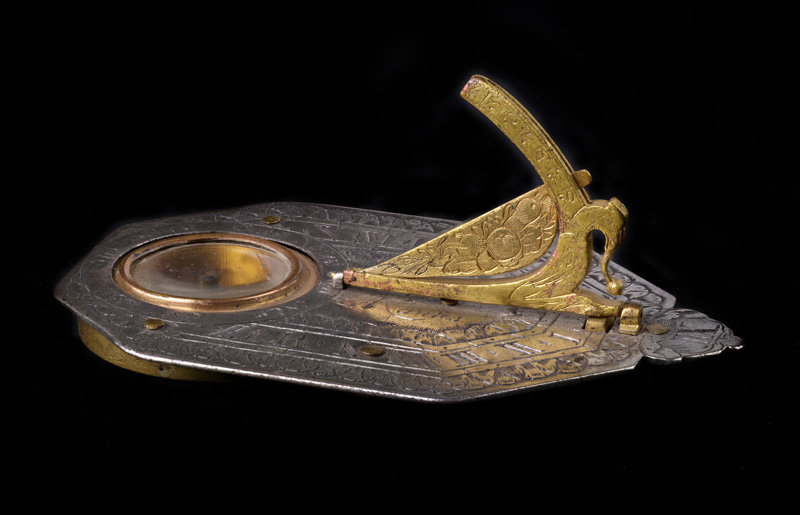 Smithsonian Collection - Pocket sundial by Bourgaud of Nantes, 1660–1675. (MA.325565) Smithsonian Collection - Pocket sundial by Bourgaud of Nantes, 1660–1675. (MA.325565) |
From the National Museum of American History is an article about "How did a French pocket sundial end up buried in a field in Indiana?" published 20 July 2022 by Kidwell & Schechner.
It started in 1860 when Dr. Elisha Cannon, while plowing a field in Indiana, came across a strange object. It was a French Butterfield sundial. It ended up in the Smithsonian collection 100 years later, where it quietly sat until recently when curator Peggy Kidwell wanted to learn more. She contacted Dr. Sara Schechner, David P. Wheatland Curator of the Collection of Historical Scientific Instruments at Harvard University, to join the investigation.
The dial is inscribed "Bourgaud Nantes" showing it was from the workshop of a clockmaker in Nantes, France. As with all Butterfield dials it contained a magnetic compass with declination corrections for orienting the dial to north and a miniature plumb bob to hold the dial level. The gnomon support is in the traditional shape of a bird allowing the gnomon itself to be adjusted to a range of latitudes. Look closely at the chapter ring of hour marks in Roman numerals. Outside the numerals is one hour line scale and on the inside of the numerals is a second scale. The user could approximate the time between these two scales, done for the extreme latitudes 30 and 55 degrees.
"In her research on sundials in the American colonies, Schechner has drawn attention to several of these dials, and notes that some 18th-century French sundial makers, like Pierre le Maire (and his son of the same name), made pocket dials that carefully listed the latitude of places of French interest in both North and South America." How did the dial end up in Indiana? It could have been carried there by Dr. Cannon and his wife Gulielma, Quakers who in 1840 left North Carolina, finding that "living in a state where African Americans were legally enslaved was intorable." Or the dial may have been left a century earlier when the French occupied much of what is now Indiana, leaving outposts such as Terre Haute and possibly a lost sundial.
Read the article: https://americanhistory.si.edu/blog/pocket-sundial
Hudson Valley's Missing Sundial
- Details
- Hits: 8555
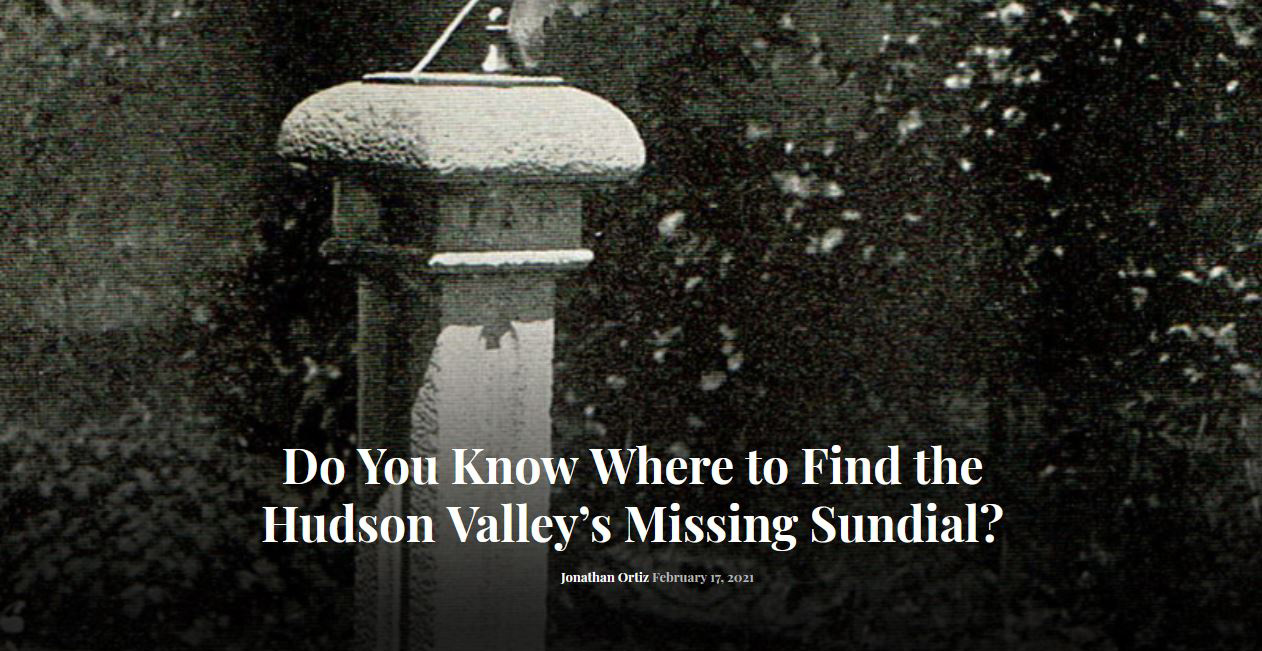
This article is reproduced by permission from Hudson Valley on-line magazine of Feb 17,2021 and can accessed directly at https://hvmag.com/life-style/history/missing-sundial-hudson-valley-hillside-dean-sage/ It was written by Jonathan Ortiz with information from NASS/BSS member Martin Jenkins and fellow researcher Kevin Franklin.
Menands’ village historian dives headfirst into the past to discover the whereabouts of a sundial that once resided at the Hillside estate in Albany County. There’s a mystery to solve in the Hudson Valley. It involves a cast of unlikely players: a local historian, a British society, a wealthy Albany County businessman, and a famed Scottish novelist.
|
|
The object of their attention? A missing sundial. Its last known whereabouts are the estate of Dean Sage, in Albany County’s village of Menands, which lies inside the Town of Colonie; however, this conundrum begins much, much farther away — in Scotland, to be exact.
“It’s a trans-Atlantic mystery,” says Kevin Franklin, Menands’ village historian and a former Menands police officer.
In 2020, Franklin was contacted by Martin and Janet Jenkins, two members of the British Sundial Society. They sought information about Hillside, the former Albany County estate of Dean Sage, son of Henry W. Sage of famed lumber firm H.W. Sage Co. fame. Hillside is located on the north side of the Menand Road (now State Rt. 378).
Interestingly enough, their purpose in finding this sundial makes the story ever more complicated. The device once located in Menands is actually a replica of another sundial from the Abbottsford estate of famed Scottish writer Sir Walter Scott. Now, there stands only a pedestal upon which the original sundial once sat.
“It is not known what the Scott sundial looked like,” writes Martin Jenkins in a letter to Franklin. “If the replica sundial made for Hillside could be traced, then a replacement replica could be made for Abbotsford in Scotland, the pillar then no longer standing silent and unadorned.”
Several books make reference to both the original sundial and the replica. Most recently the March 2019 edition of the British Sundial Society Bulletin by Denis Cowan refers to the fact that a replica sundial was made for “Hillside, Menands, NY.” The 1902 edition of Sun-Dials and Roses of Yesterday by Alice Morse Earle shows the replica sundial to be in existence at Hillside, in the Shakespeare Garden border. In Ye Sundial Booke by T. Geoffrey W. Henslow in 1914, there are two sketches, one showing the sundial pillar at Abbotsford, Scotland, and the other depicting the replica sundial at Hillside.
Lastly, in The Book of Sun-Dials, the author Margaret Gatty apparently made her sketch of the sundial pillar at Abbotsford in 1839, but, by then, the sundial was missing — more than likely stolen.
Despite extensive documentation, many questions remain. What was the connection between Sir Walter Scott and Hillside? Who commissioned the Hillside replica? And, most importantly, what happened to the replica?
It was here that Franklin picked up the trail, starting with the local angle: Dean Sage.
“The Sages were immensely wealthy,” explains Franklin. “Their wealth evolved around the exporting of lumber from the Michigan area across the Erie Canal to the ‘Lumber District’ of Albany.”
Researching Sage’s background did reveal one important fact, and the potential connection between him and Scott: Sage was both a bibliophile and an avid fisherman.
|
Replica of Sir Walter’s Sundial | Photo by Alice Morse Earle, public domain |
He wrote the famous fly fishing book Ristigouche and Its Salmon Fishing in 1888. It was published by David Douglas of Edinburgh, whose name also appears in Sun-Dials and Roses of Yesterday. There, it is stated that Sage’s replica sundial was, “commissioned by the publisher Douglas.”
Douglas has another publisher’s credit — in The Journal of Sir Walter Scott. Scott kept a daily journal from 1827 until his death in 1832. These journals were published in 1890 by the very same Douglas who published for Sage.
While Sage, born in 1841, could never have met Scott, who died in 1832, it is well known that Abbotsford is on the banks of the River Tweed and has been famous for salmon fishing since Roman times. The Tweed Commissioners whose responsibility it was to manage the river and its fish was set up by Scott in 1805. It seems likely that Dean Sage visited Abbotsford at some time as part of his salmon fishing interest.
“It would not be beyond the realm of imagination for Dean Sage to have gotten either a sketch or drawing, maybe even a photograph, of this sundial at least the base that still remains at the Abbottsford and had that duplicated,” explains Franklin.
The final question remains: Where is the Hillside sundial?
Mr. Franklin continues to follow up with past residents of the area and any leads which would help locate the missing sundial of Hillside.
Have any info on the missing Hillside sundial? Send any information or clues to this local mystery to This email address is being protected from spambots. You need JavaScript enabled to view it., or directly to Kevin Franklin at This email address is being protected from spambots. You need JavaScript enabled to view it..
[You may also send any information to the North American Sundial Society, at This email address is being protected from spambots. You need JavaScript enabled to view it. ]
Virtual Tour of Jantar Mantar Solar Observatory
- Details
- Hits: 14490
 Google Arts and Culture offers you to take a virtual tour of the 13th century observatory Jantar Mantar in Delhi. At the opening view (see the website link below), the Google tour explains: "Innovations in architectural astronomy: The Jantar Mantar Obervatory, Delhi's outdoor astronomical observatory is the earliest of five observatories built by Sawai Jai Singh II across India. It is dominated by a huge sundial and houses other innovative instruments that help plot the course of heavenly bodies...."
Google Arts and Culture offers you to take a virtual tour of the 13th century observatory Jantar Mantar in Delhi. At the opening view (see the website link below), the Google tour explains: "Innovations in architectural astronomy: The Jantar Mantar Obervatory, Delhi's outdoor astronomical observatory is the earliest of five observatories built by Sawai Jai Singh II across India. It is dominated by a huge sundial and houses other innovative instruments that help plot the course of heavenly bodies...."
"The Maharaja designed four similar observatories in Jaipur, Ujjain, Mathura and Varanasi to help and improve upon the studies of space and time. The Jantar Mantar in Jaipur is now the largest among them." Google gives us a glipse of the large equatorial dial of the Man Singh Observatory in Varanasi and then focuses on the four large brick and plaster instruments at Jantar Mantar: the Ram yantra, two circular structures next to each other used to observe celestial objects; the Samrat yantra, one of the largest equatorial dials in the world with stairs leading to the top of the triangular gnomon (looking like stairs to the heavens) and surrounded by a large equatorial band to measure solar time; the Jai Prakash yantra that consist of two elaborate sunken hemispheres so large that there are stairs from the bottom leading between huge longitudinal bands; and the Misra yantra, which is shaped like a heart and is composed of five different sun and alignment instruments to determine the shortest and longest days of the year at the solstices.
Take a personal visit to these historic astronomical and solar instruments at: The Jantar Mantar Observatory - Google Arts & Culture
Harvard Collection of Diptych Sundials
- Details
- Hits: 12803
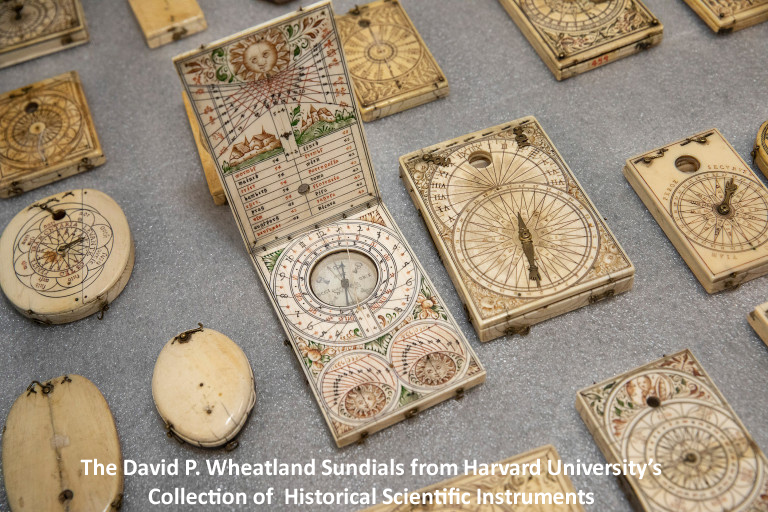 From the Harvard Gazette - Dec 9, 2019 : "Since 1672 Harvard University has been acquiring scientific instruments for teaching and research. In 1948 the Collection of Historical Scientific Instruments was established...[and has] grown to more than 20,000 objects making it one of the three largest university collections of its kind in the world"
From the Harvard Gazette - Dec 9, 2019 : "Since 1672 Harvard University has been acquiring scientific instruments for teaching and research. In 1948 the Collection of Historical Scientific Instruments was established...[and has] grown to more than 20,000 objects making it one of the three largest university collections of its kind in the world"
As an illustration of the collection is a photograph of ivory pocket sundials shown here, made in Nuremberg, Germany between 1575 and 1645. These elegant diptych sundials represented the 16th and 17th century equivalent of pocket watches, especially for wealthy traveling merchants to keep track of time. "Harvard has the largest collection of sundials in North America, a gift of David P. Wheatland, Class of 1922."
As described by Dr. Sara Schechner in Time of Our Lives - Sundials of the Adler Planetarium who is the David P. Wheatland Curator of Historical Instruments at Harvard describes the diptych as "fashioned from ivory, gilt brass, carved wood, and wood covered by printed paper. The materials offer hints on the social status of their owners. So too do common and novel accessories found on the instruments. A directory of cities and their latitudes suggests an owner who traveled... The association is stronger when the diptych combines a gazetteer with particular sundials that found the time according to the sundry conventions of England, France, Germany, and Italy. A merchant crossing a border would have needed to know how to set up an appointment with his clients. How many hours would there be to transact business or to journey along the road? Calendrical devices on the diptych showed him the length of the day and night throughout the year...[and] the diptych's lunar volvelle gave ...the moon's phase. It also assisted the owner in finding the time by moonlight...[And] a diptych with a magnetic compass [allowed proper and immediate orienting the sundial]."
Read more at: https://news.harvard.edu/gazette/story/2019/12/collection-of-historical-scientific-instruments-continues-to-amaze/
Mystery of 1733 Sundial
- Details
- Hits: 15023
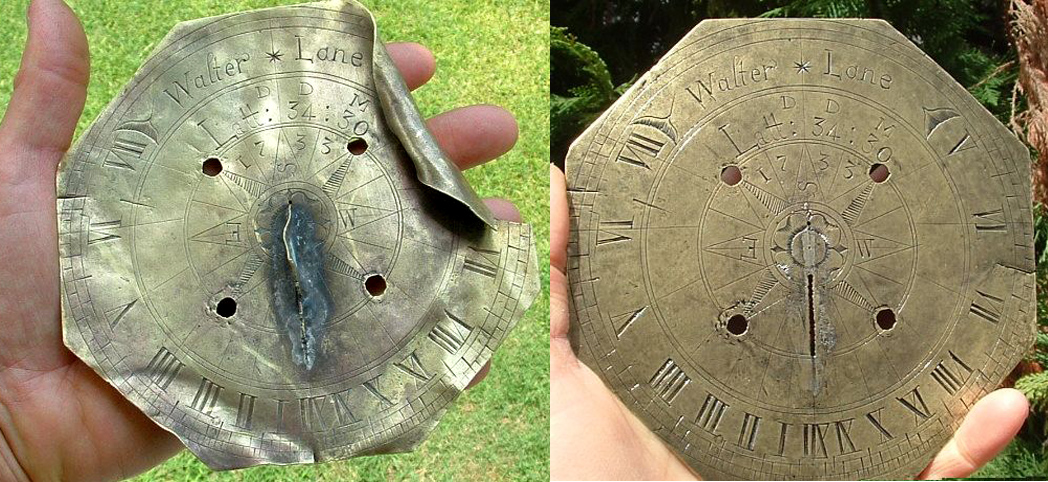 It started simply enough. Keith, a "treasure hunter" reported finding a 1733 sundial "in the Carolinas". (http://www.treasurenet.com/forums/my-best-finds/603181-1733-colonial-sundial-found-restored.html). The brass sundial about 5 or 6 inches in size was found crumpled and apparently had a number of modern attempts to solder a gnomon back onto the dial plate. Kieth reported, "When I found the piece it had been bent and damaged so I sent it to an expert in restoring metal objects....It has been the best find of my relic hunting career. I hope to get some detailed info from people who know about sundials."
It started simply enough. Keith, a "treasure hunter" reported finding a 1733 sundial "in the Carolinas". (http://www.treasurenet.com/forums/my-best-finds/603181-1733-colonial-sundial-found-restored.html). The brass sundial about 5 or 6 inches in size was found crumpled and apparently had a number of modern attempts to solder a gnomon back onto the dial plate. Kieth reported, "When I found the piece it had been bent and damaged so I sent it to an expert in restoring metal objects....It has been the best find of my relic hunting career. I hope to get some detailed info from people who know about sundials."
The dial is done in the English style of the period, that is to say, the dial is cut as an octogon with a circular chapter ring with Roman numerals and delineated on the outside to the quarter hour. In the center is an 8-point compass rose with the cardinal points labelled "N,S,E,W". Four crude and somewhat modern screw holes held the dial to some modern base. The maker's initials D.D.M. are berlow the engraving of the original owner "Walter * Lane" with the date 1733.
As Kieth notes, "[The dial] is one of the earliest from southern colonial America". But the problem is where? The engraved latitude is "Latt: 34:30". Using Serle's ruler confirms that the delineated hour lines are between 34 and 35 degrees. That should allow a quick check of southern cities to identify the home of this dial. The center of population in the 1750's was Willmington, NC at 34:14. If we assume that William Lane was a farmer a person of means, then two possibilities arise: Blenheim SC and Laurens SC both at 34:30. Laurens County, in particular, was in the area where thousands of immigrants, mainly Scottish and Irish, settled in the pre-revolution Carolinas. Then there is Kershaw SC at 34:32 which was settled around 1732 by English traders and farmers who moved inland from Charleston. What was the provinance of this dial? We may never know, but you can search the below 1755 map from University of North Carolina library of historic maps for towns and river portsat: https://dc.lib.unc.edu/cdm/ref/collection/ncmaps/id/123
NEW INFORMATION:
A descendent of Walter Lane sent the following: Walter Lane lived in New Bern, Craven County, North Carolina. Apparently he left Maryland in the 1720's and by 1726 showed up in records of Craven County. In 1729 he was listed as a Commisioner of New Bern, and probably a person of means. The sundial could very possibly be his. Looking at the map below, New Bern is just north of latitude 35 degrees on the mouth of the Neus [Neuse] river. If we accept the latitude of the dial as 34:30, Walter lived about 35 miles south of New Bern, perhaps on a farm near Wilmington, S.C. Old records show that much of South Carolina in 1734 was considered Craven County.
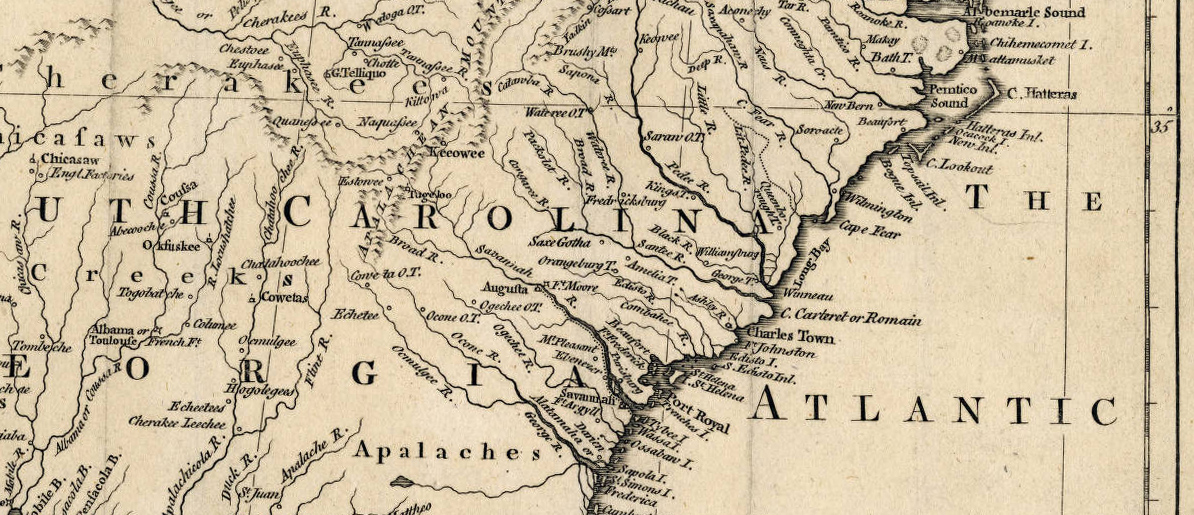
World's Oldest Mariner's Astrolabe
- Details
- Hits: 14323
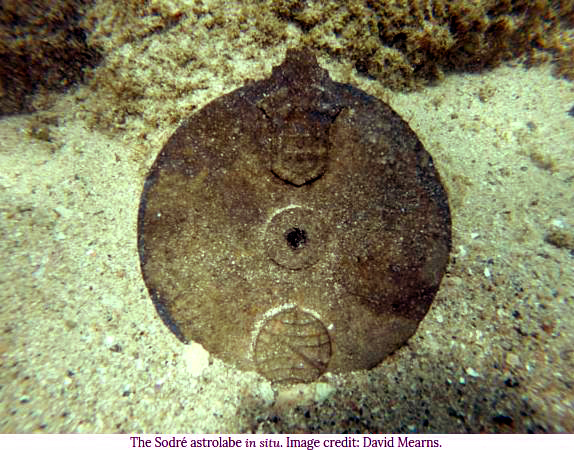 A team led by David Mearns reported on the oldest Mariner's Astrolabe in a recent article of the International Journal of Nautical Archaeology. During a 2013-2014 series of diving expeditions off the coast of Oman they discovered a Portugues solid leaded-gunmetal disk astrolabe. As the authors put it, "A well-documented and dramatic story from one of the earliest Portuguese foyages to India ... involves the loss off two naus [sailing vessels], the Esmeralda and Sao Pedro, which sank in shallow waters off the coase of a remote Omani Island in the Arabian Sea." What has made this legend is that these ships were part of a Portuguese armada to India led by the legendary explorer Vasco da Gama. Mearns tells the story that following the return of da Gamma and the main fleet to Portugal in February 1503, Vicente and Bras Sodre, uncles of da Gama, led their two ships back to patrol the waters off the south-west Indian coast. But Vicente sailed his squadron to the Gulf of Aden where they looted and burnt a handful of Arab ships. "Vicente then took his ships to Al Hallaniyah ...where they found a safe anchorage to shelter from the south-west monsoon...It was in this location, in May 1503, where a sudden and furious wind tore the two naus from their moorings and drove them against the rocky shoreline smashing their wooden hulls and causing the deaths of many crew, including the squadron commander Vcente Sodre"
A team led by David Mearns reported on the oldest Mariner's Astrolabe in a recent article of the International Journal of Nautical Archaeology. During a 2013-2014 series of diving expeditions off the coast of Oman they discovered a Portugues solid leaded-gunmetal disk astrolabe. As the authors put it, "A well-documented and dramatic story from one of the earliest Portuguese foyages to India ... involves the loss off two naus [sailing vessels], the Esmeralda and Sao Pedro, which sank in shallow waters off the coase of a remote Omani Island in the Arabian Sea." What has made this legend is that these ships were part of a Portuguese armada to India led by the legendary explorer Vasco da Gama. Mearns tells the story that following the return of da Gamma and the main fleet to Portugal in February 1503, Vicente and Bras Sodre, uncles of da Gama, led their two ships back to patrol the waters off the south-west Indian coast. But Vicente sailed his squadron to the Gulf of Aden where they looted and burnt a handful of Arab ships. "Vicente then took his ships to Al Hallaniyah ...where they found a safe anchorage to shelter from the south-west monsoon...It was in this location, in May 1503, where a sudden and furious wind tore the two naus from their moorings and drove them against the rocky shoreline smashing their wooden hulls and causing the deaths of many crew, including the squadron commander Vcente Sodre"
Recovered from the ocean after 500 years was the 17.5 cm 344 gram metal Sodre astrolabe as well as more than 2000 other metal and ceramic artifacts. The were slowly desalinated over a period of two years. The astrolabe was clearly decorated with the Portuguese royal coat of arms at top and an esfera armilar (armillary sphere) at bottom. But there was no alidade or any visible gradations. Using laser imagery a total of 18 scale marks became visible along the limb of the upper right quadrant with a spacing of 5 degrees. These marks probably extended to make a full 90 degree quadrant. The solid metal Sodre astrolabe is a rarity, for shortly after 1500 a new generation of open ring astrolabes emerged. An illustration of a mariner's astrolabe from the Boria Chart (1529) shows a ring planisphere with angles marked for 180 degrees. The new open design remaind stable in the wind and became the dominant navigation instrument for the next 170 years. Read the full article at https://onlinelibrary.wiley.com/doi/epdf/10.1111/1095-9270.12353 or a short condensed version at World’s Oldest Mariner’s Astrolabe Found | Archaeology | Sci-News.com
Armenian Sundials - Necessity Becomes History
- Details
- Hits: 14539
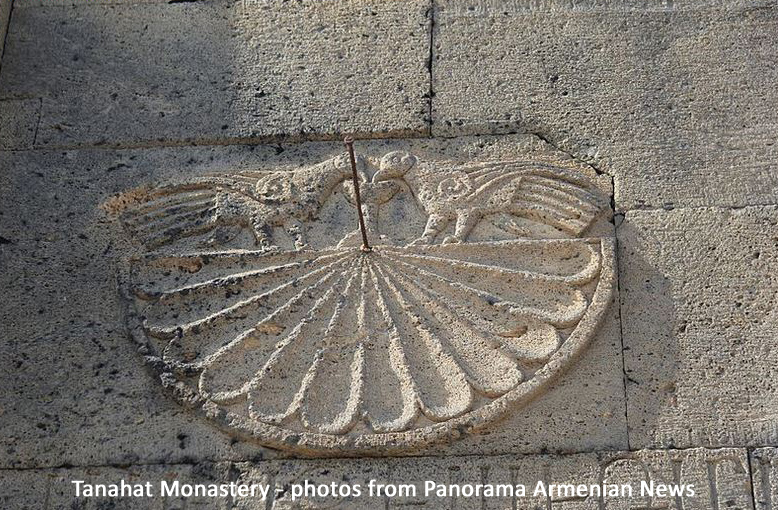 Last February in the Panorama Armenian News an article reviewed some of the oldest sundials in Armenia. Piliposyan, Doctor of History at the Preservations Service for Historic-Cultural Reserve-Museums and Historic Environment (SNCOT) related that the oldest sundial may be on the Zvartnots temple dating to the 7th century. Sundials have been preserved on buildings of Dsegh, Tsakhkadzor, Dilijan, Noyemberyan as well as Nagorno Karabakh churches. Sundial also were curved on khachkars [Armenian cross-stones]. In the Panorama article Piliposyan said that apart from serving as clocks, sundials served as a means of communicating with god. He brought the example of the Zvartnots temple sundial found during excavations with enclosed documents calling on prayers to talk to god whatever time it was.
Last February in the Panorama Armenian News an article reviewed some of the oldest sundials in Armenia. Piliposyan, Doctor of History at the Preservations Service for Historic-Cultural Reserve-Museums and Historic Environment (SNCOT) related that the oldest sundial may be on the Zvartnots temple dating to the 7th century. Sundials have been preserved on buildings of Dsegh, Tsakhkadzor, Dilijan, Noyemberyan as well as Nagorno Karabakh churches. Sundial also were curved on khachkars [Armenian cross-stones]. In the Panorama article Piliposyan said that apart from serving as clocks, sundials served as a means of communicating with god. He brought the example of the Zvartnots temple sundial found during excavations with enclosed documents calling on prayers to talk to god whatever time it was.
The vertical dials had horizontal gnomons and on the dial face there are typically 12 equally spaced divisions to mark the hours. Frank King commented on the dials that "These are variants of the standard European sundials used for indicating 'unequal [temporal] hours', at least approximately, in medieval times. Several thousand survive in England alone. They divide the daylight period from sunrise to sunset into 12 parts. Unfortunately, these parts are not equal in time and their relationship varies with the time of year....The examples in the photographs seem very nicely made."
To appreciate the Medieval Armenian dials as well as modern interpretations, visit https://www.panorama.am/en/news/2019/02/23/Armenian-sundials/2076856
Frederick Douglass Sundial
- Details
- Hits: 12795
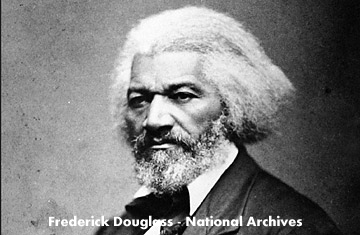 The Frederick Douglass home, also know as Cedar Hill, is located at 1411 W Street, SE in Anacostia. After Douglass' death in 1895, his widow Helen Pitts Douglass (a suffragist and abolitionist) founded the Frederick Douglass Memorial and Historical Association in 1900. In 1916, the National Association of Colored Women's Clubs joined with the association and jointly owned the house until 1962.
The Frederick Douglass home, also know as Cedar Hill, is located at 1411 W Street, SE in Anacostia. After Douglass' death in 1895, his widow Helen Pitts Douglass (a suffragist and abolitionist) founded the Frederick Douglass Memorial and Historical Association in 1900. In 1916, the National Association of Colored Women's Clubs joined with the association and jointly owned the house until 1962.
One of the Colored Women's Clubs, the Married Women's Culture Club of Pittsburgh, contributed a sundial to the Douglass House in 1922 when it was opened as a national museum. The sundial contains a challenging motto: "My face marks the sunny hours. What can you say of yours?"
According to an article in the Pittsburgh Post Gazette by Mark Holan (http://www.post-gazette.com/opinion/Op-Ed/2018/07/22/Marking-time-with-Frederick-Douglass/stories/201807220003) "The reasons that the Married Women’s Culture Club chose a sundial to donate to Cedar Hill are unknown. Having 'secured the dial and prior to sending it east for installation at the grounds,' the club held a July 9, 1922, dedication ceremony at Pittsburgh’s Euclid Avenue A.M.E. Church,' according to The Pittsburgh Press.... Just three Augusts after the Cedar Hill ceremony, more than 30,000 members of the Ku Klux Klan paraded down Pennsylvania Avenue. Even in the darkest of times, however, the Pittsburgh women’s gift of that sundial at Cedar Hill has marked the sunny hours."
You can read more about the history of the Douglass House and see a photo of the 1922 sundial at http://allenbrowne.blogspot.com/2012/09/cedar-hill.html The photo taken by Allen Browne shows the dial has survived the years well, except that someone has reinstalled the gnomon backwards.

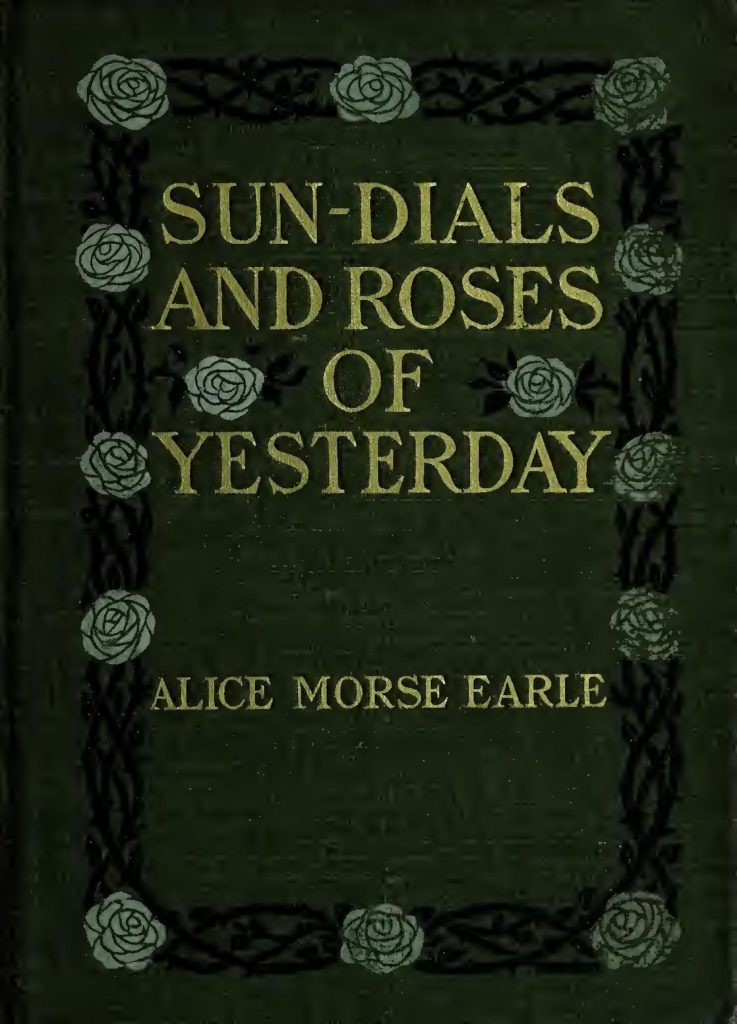 Sun-Dials and Roses of Yesterday / Wikimedia Commons
Sun-Dials and Roses of Yesterday / Wikimedia Commons